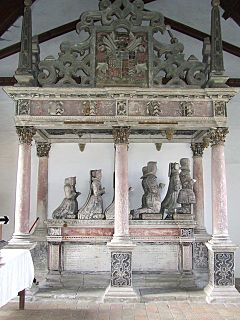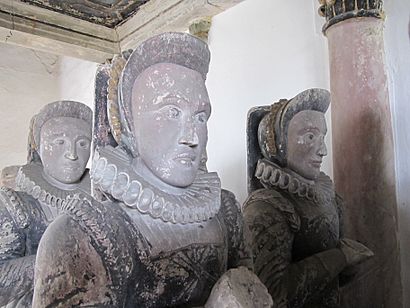Edward Lewknor (died 1605) facts for kids
Sir Edward Lewknor (1542 – 19 September 1605) was an important leader among the puritan gentry in East Anglia during the later years of Queen Elizabeth I's reign. He was also a strong voice on religious topics in the English Parliament.
Contents
Early Life and Family
Edward Lewknor was the oldest son of Edward Lewknor, a courtier from Kingston Buci, Sussex. His mother was Dorothy Wroth. Edward's father had a good career at court, especially when King Edward VI was on the throne. However, when Queen Mary became queen in 1553, things changed.
Edward's father became involved in a plot against Queen Mary. In 1556, he was found guilty of treason, a very serious crime against the country. He was sent to the Tower of London and died there in September 1556. This was a huge change for young Edward, who was only 14 years old.
However, things improved for the family. In 1557, many of their lands were given back to his mother. Then, when Queen Elizabeth became queen, a special law was passed. This law restored Edward and his nine brothers and sisters to their family's good name and status. This meant they could inherit property as if their father had never been found guilty of treason.
With his family's status restored, Edward went to St John's College, Cambridge in 1559. He earned his degree in 1561. He then studied law at the Middle Temple in 1562. His son later wrote that Edward also worked for Queen Elizabeth in her royal household.
Marriage and Moving to Suffolk
Around 1570, Edward Lewknor married Susan Heigham. She was the daughter of Sir Thomas Heigham from Higham Hall, Suffolk. After his marriage, Edward moved to Denham in Suffolk, near his wife's family. He started his own family there, and his male descendants lived there for three more generations.
This move connected him to important families in East Anglia. These families, including Susan's relatives, were often strong supporters of the Puritan movement. Puritans were Protestants who wanted to "purify" the Church of England and make it simpler. Edward quickly became an active leader in this group.
Susan's mother, Martha Heigham, was also a strong Puritan. She owned Denham Hall, where Edward and Susan lived. Martha's minister, Robert Pricke, stayed in Denham for 30 years. The Lewknors, Heighams, and Jermyns (another related family) were all very involved in supporting Puritan ministers and ideas. They also helped establish Emmanuel College, Cambridge, which was known for its Puritan teachings. Edward's son later studied there.
A Career in Parliament
Edward Lewknor had a successful career in Parliament. He was supported by important Puritan leaders like the Earl of Leicester.
- In 1571, he became a Member of Parliament (MP) for Tamworth.
- In 1572, he was elected MP for New Shoreham.
- He was also elected MP for Maldon in 1584 and 1586.
Lewknor, along with Sir John Heigham and Sir Robert Jermyn, led a strong Puritan group in Parliament. They often worked together to push for changes in the church. They wanted to make sure that clergy (church leaders) were well-educated. They also wanted to reform the power of bishops.
In 1584, Lewknor supported a bill to make people observe Sunday (the Sabbath) more strictly. This was seen as interfering with church affairs and was not popular with the Queen. Later, he helped consider requests for more freedom for "godly preachers."
In 1587, a new version of the Book of Common Prayer was proposed in Parliament. Lewknor spoke in favor of it, hoping to fix some church problems. However, Queen Elizabeth did not approve. As a result, Edward Lewknor and three other MPs were sent to the Tower of London for about a month. This showed that even important MPs could be punished for challenging the Queen's authority.
Later Life and Death
Lewknor continued his work in Parliament. He was MP for Maldon again in 1589 and 1593. In 1594, he sold some family lands. He also inherited large estates from his mother-in-law, Martha Heigham, who died in 1593. She had set up a scholarship at Emmanuel College, which Edward helped to put into action.
In 1598, Edward Lewknor was MP for Newport, Cornwall. He remained active in Parliament, working on important issues like helping the poor. In 1603, he was knighted by King James I. He was elected MP for Maldon again in 1604. He continued to focus on church and religious questions. He believed that ministers should only have to agree to the Thirty-nine Articles (a set of beliefs) and not the Prayer-book, so that more "godly ministers" could serve in the church.
In 1605, a smallpox outbreak happened. Edward and Susan Lewknor's sons were called home from Cambridge to avoid it. Sadly, a friend brought the infection with him. In early October 1605, both Sir Edward and his wife, Dame Susan, died from the disease on consecutive days.
Sir Edward and Dame Susan were buried in St Mary's church in Denham on 5 October 1605. Their eldest son, Edward, became his father's heir. A large funeral was held later, with many family members attending. Edward's son also built an elaborate monument in the church. It features stone carvings of Sir Edward, his wife, and their eight children praying. The monument also shows their family coats of arms, representing their long history.
The Latin inscription on the tomb praises Sir Edward for his loyal service to the court, Parliament, and the country. It also mentions his work to bring the preaching of the Gospel to Denham. Dame Susan is praised for her modesty, kindness, and generosity to the poor.
Children
Sir Edward Lewknor and his wife Susan Heigham had several children:
- Dorothie (1575–1603), who married Robert Castell. She died before her parents.
- (Sir) Edward (1586–1618), who inherited Denham Hall. He was knighted in 1606. He was an MP for West Looe in 1614 and served as High Sheriff of Suffolk in 1617. He married Mary Neville and had six children.
- (Sir) Robert (1588–1636), who was knighted in 1607. He inherited lands in Kent and was High Sheriff of Kent in 1630. He married Mary Hamon and had five children.
- Hester (died 1612), who married Sir Robert Quarles in 1601. Robert was the brother of the famous poet Francis Quarles.
- Anne (died 1608), who married Godfrey Rodes around 1598. They had five children.
- Martha (died before 1639), who married Thomas Gurney. They had eight children.
- Sarah, who married Thomas Stuard. Six of their children were christened in Denham.
- Elizabeth (born 1591), who married Thomas Catelyn. They had three children.
- Susan (died 1609), who died without having children.






